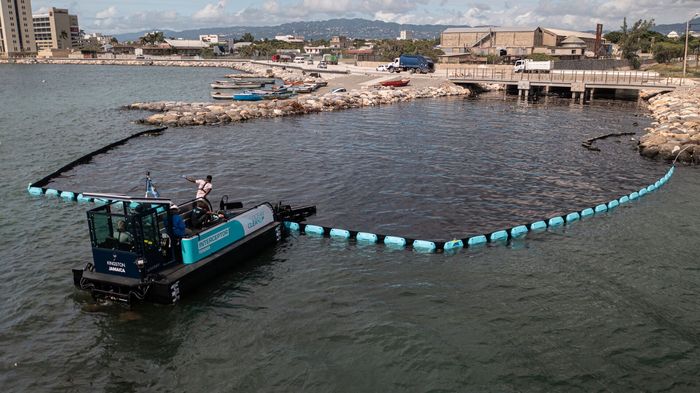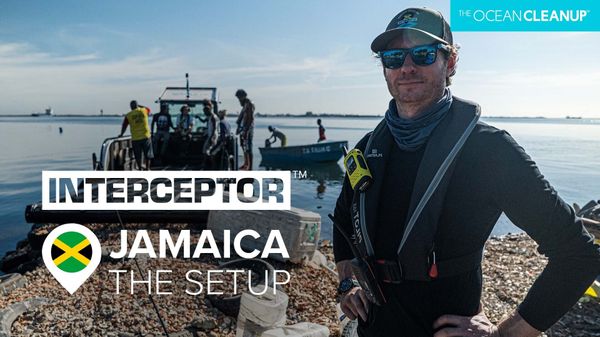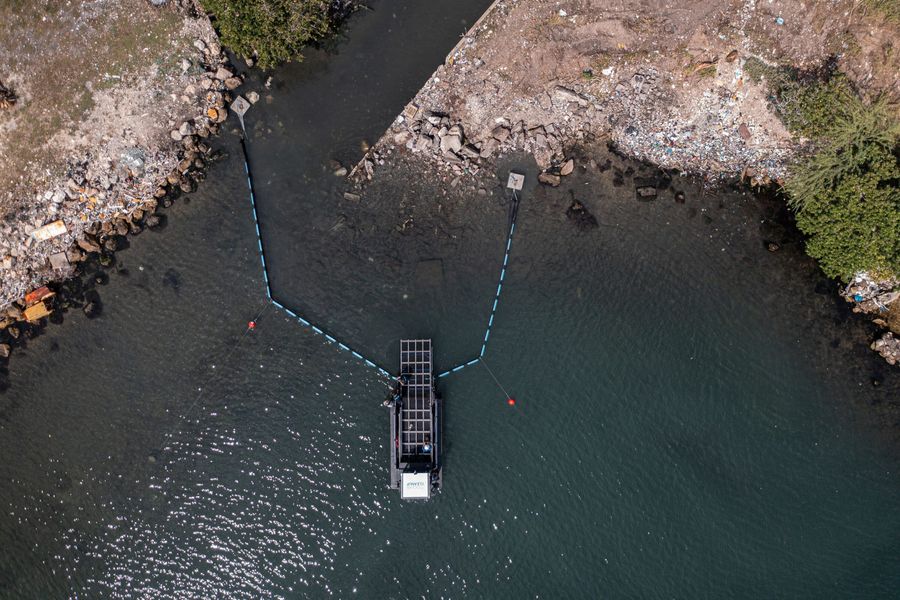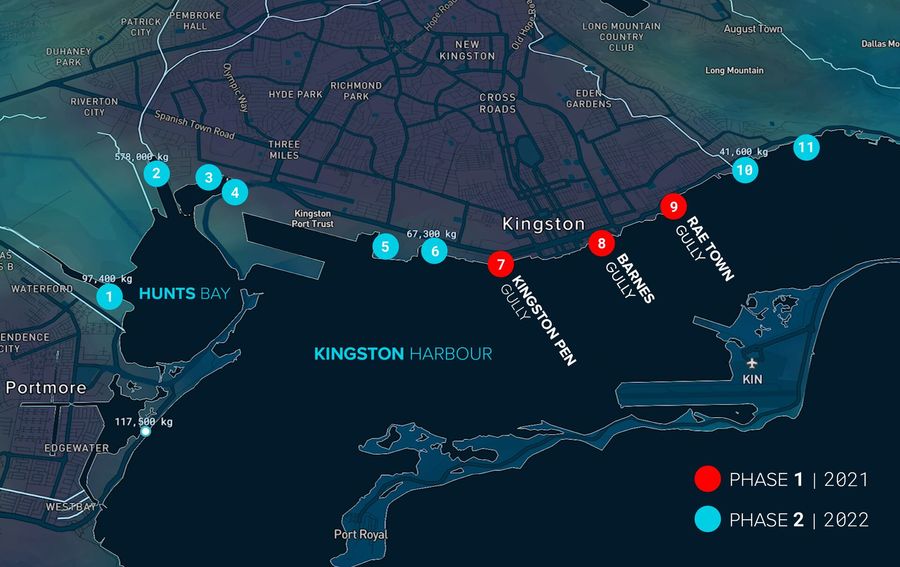
Expanding the Interceptor Family
Back to updatesAt The Ocean Cleanup, our mission is to rid the oceans of plastic. In addition to cleaning up legacy pollution in the oceans, our mission requires us to eliminate the flow of plastic that continues to enter oceans every day. Rivers are the main pathway through which plastic enters the oceans. Our 2021 paper in Science Advances shows that almost 80% of plastic emissions into the oceans come from 1000 rivers. We believe that extracting plastic in these 1000 rivers is one of the fastest and most cost-effective ways to close the tap. By stopping plastic pollution in rivers today, we can halt the exponential growth of plastic pollution in the oceans. Simultaneously, we buy the world time to develop long-term solutions, such as improved waste management infrastructure and replacing plastics with eco-friendly materials.
To tackle plastic debris within the heaviest-polluting rivers of the world, we developed the Interceptor. A solar-powered and automated device, an Interceptor anchors in the mouth of a river. There, it catches and extracts floating plastic before it can enter the ocean.
DESIGNED TO SCALE
Considering the large number of rivers that we need to clean in order to achieve our goals, a key design feature of the Interceptor is its scalability: the Interceptor is designed for series production. In December 2020, we contracted with Konecranes to produce a large number of Interceptors in years to come. As of December 2021, the firm has delivered two 3rd generation Interceptors, with two more platforms slated for completion by early 2022. Additional Interceptors will be manufactured as our deployment needs increase over time.
We have consciously aimed to make the Interceptor suitable for a wide array of rivers. Every river is different; factors like river width, depth, flow speed, debris composition, seasonality, and tides all massively influence the success of a river intervention.
For example, the man-made canal in Jakarta, where Interceptor 001 is active, differs from the wide natural river where we have deployed Interceptor 004. That river, the Rio Ozama, does not experience tides, which is again very different from the Klang River (Interceptor 002), where a tidal difference of up to five meters can occur. If we had approached each river with a dedicated technical solution, our scale-up would take way too much time. Therefore, we designed the Interceptor like a product; suitable for many rivers around the world.
Yet, based on our understanding of the 1000 most polluting rivers, we also realized that a single solution would not be sufficient to handle all conditions we will face during scale-up. Thus, we are creating a family of Interceptor Solutions. Imagine it as a toolkit: whenever we start to investigate a problem river, we first ask ourselves: “Given the specific set of circumstances in this river, what is the best type of Interceptor solution to address the problem here?”
We estimate that 30% of rivers in our top 1000 target list are either too shallow or too narrow to allow deployment of an Interceptor Original. We encountered this situation when we started work in Kingston, Jamaica. Here, 11 small streams (drainage canals, locally known as gullies) together emit an estimated 947,000 kg of plastic into the Caribbean Sea every year. Most, if not all, of these gullies, turn out to be too small for an Interceptor Original.

INTRODUCING: INTERCEPTOR BARRIER & INTERCEPTOR TENDER
To tackle small and heavily polluting rivers, such as those found in Jamaica, The Ocean Cleanup has added two new tools to our toolkit: the Interceptor Barrier and the Interceptor Tender. The Interceptor Barrier can be used to halt debris at the mouth of a small river or canal. It consists of a standalone floating barrier that, once anchored on each side, forms a U-shape. Debris floats down the waterway until it reaches the barrier, which then holds it in place until operators can remove it. The Interceptor Barrier design builds on the experience from our existing efforts to concentrate floating debris towards the mouth of an Interceptor Original.
The Interceptor Barrier is paired with our extraction device, the Interceptor Tender. Developed in collaboration with Berky GmbH, the Interceptor Tender is a small, powered barge that uses a conveyor belt to scoop up the trash trapped by our barrier. The Interceptor Tender can move between barrier sites to collect, then offload, debris into an onshore dumpster.
An advantage of having a mobile extraction and offloading unit is that it can serve several barrier locations. At future deployments in Jamaica, as well as other destinations, we expect to see multiple Interceptor Barriers located near one another. This way, extraction, and offloading equipment costs are shared over multiple Interceptor deployments.

In the coming months, we will be testing the combination of Interceptor Barriers and an Interceptor Tender in three of Kingston’s gullies (Kingston Pen Gully, Barnes Gully, and Rae Town Gully). If results are positive, in 2022 we will deploy in all of Kingston’s remaining gullies.
PARTNERING FOR SUCCESS
Our partners in Jamaica are GraceKennedy Foundation and Clean Harbours Jamaica. GraceKennedy Foundation is one of the Caribbean’s largest community service groups. The Foundation is leading ongoing education and outreach, with one of its goals being to protect the mangroves. The Clean Harbours Jamaica organization oversees the restoration of natural harbors, gullies, and streams on the island. Both organizations have been able to share with us valuable insight into conditions that transpire during both the rainy and dry seasons.
Going forward, all of our river interventions will be called Interceptor deployments, and the barriers placed in Kingston will go forward as Interceptors 008, 009, and 010. However, not all Interceptor deployments will be the same, as illustrated by the introduction of Interceptor Barrier and Interceptor Tender to our family of Interceptor Solutions. As we gain familiarity with more and more of the top 1000 rivers, we look forward to the continued expansion of our toolkit.




